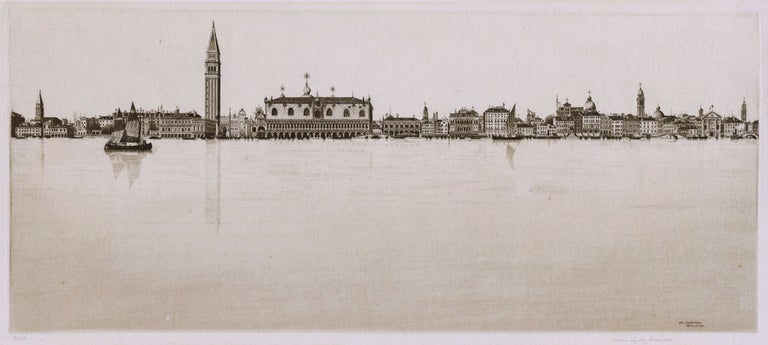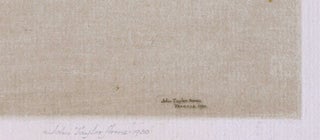La Bella Venezia
New York: John Taylor Arms, 1930. Etching on antique cream laid paper with a fancy "G" watermark, 7 1/8 x 16 1/2 inches (182 x 442 mm), full margins. Signed, dated and inscribed "Ed. 70" in pencil, lower margin. From a total edirion of 81 plus 5 trial proofs. Printed by Henry E. Carling. Number 18 from the Italian Series. A superb impression of this scarce print, with all of the subtleties and details of the reflections in the water printing clearly.
[Fletcher 232]
[Illustrated: Page 192, Arms, Dorothy Noyes, "Hilltowns and Cities of Northern Italy"].
Along with his constant companion and wife, Dorothy Noyes, Arms spent decades exploring and documenting gothic structures throughout Europe. Noyes, an accomplished travel writer, had gifted Arms an etching set for Christmas in 1913, during the time that the couple called New York home. Arms, having been trained in architecture, was sparked and fascinated by the potential for exceptional precision that etching provided as a media. His immediate projects focused on the architectural wonderland that Manhattan presented, but he quickly realized that it was no love affair for him. Jane Glaubinger, PhD., Curator of Prints, Cleveland Museum of Art, quotes a manuscript owned by the Museum in which Arms confides, “I can admire the skyscrapers of New York, that unbelievable city which is a very gold mine for the architectural etcher, but I do not love them and I cannot etch what I do not love.” Glaubinger explains in her 2012 essay, Images of Inspiration, that Arms opined that the creation of art furthered the spiritual and moral improvement of mankind, and he believed that Gothic cathedrals represented “the most significant expression of man’s aspirations.” Arms, a dedicated and industrious devotee to detail, saw printmaking as a vehicle for inspiring joy and uplift in contemporary society. Glaubinger continues, "Over several decades Arms traveled throughout France, Italy, England, and Spain drawing Gothic structures. These studies were the basis for the etchings he produced back in his Connecticut studio. Arms admired the craftsmanship of medieval art and, aided by magnifying glasses, used fine-gauge sewing needles set into wooden handles to draw the elaborate churches on copper plates. Extremely dedicated and industrious, Arms rendered each building with exceptional precision, spending 1,000 hours or more on a single plate. He was a gifted draftsman and technical virtuoso who created compositions full of keenly observed details and nuanced light."
[Glaubinger, Jane, "Modern Gothic: The Etchings of John Taylor Arms," Cleveland Museum of Art, 2012.].
Item number: 482
Price: $6,000.00
Share:

